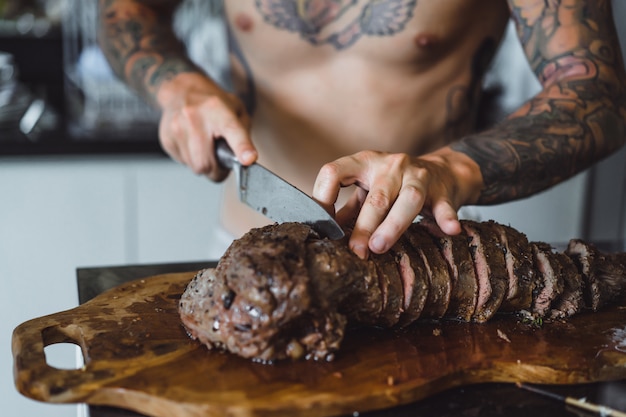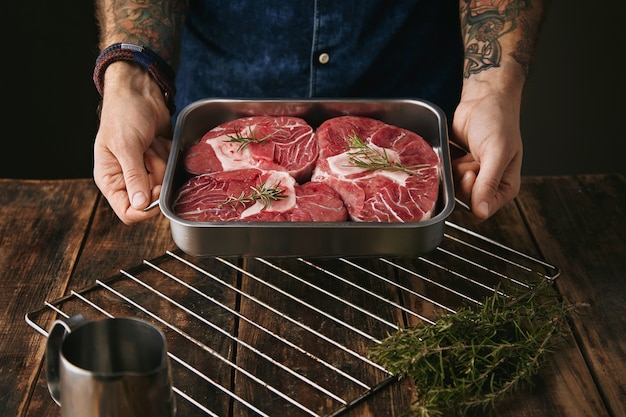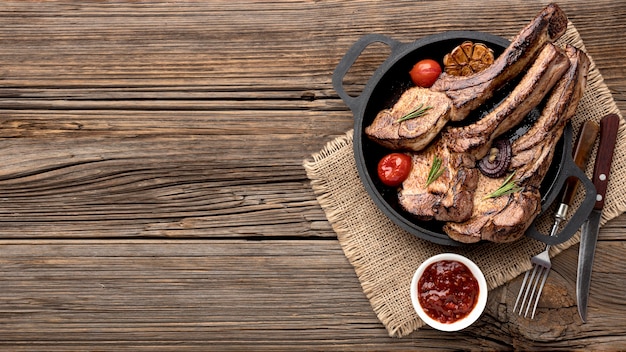(Part 1) Picking the perfect brisket

Now, the first step is crucial – choosing the right cut of brisket. It’s the heart of the dish, so you want to make sure you’re starting with a good one. There are two main types of brisket: the point and the flat. The point has more fat, which makes it juicier and more flavorful. The flat is leaner and has a more consistent texture. Now, here's where I come in – I'm a big fan of using a whole packer brisket, which combines both the point and the flat. It’s a bit more work, but the flavour payoff is worth it.
The Key to Success - Choosing the Right Brisket
Choosing the right brisket is the foundation of a successful slow cooker recipe. Here's what to look for:
- Look for a good fat cap: A thick layer of fat on top of the brisket is key. It'll melt during cooking, basting the meat and keeping it moist. You want to aim for about a half-inch thick fat cap.
- Avoid dry or discolored meat: You want a brisket that’s fresh and has a good colour. Avoid any that looks dry or discoloured. The colour should be a rich, deep red.
- Go for a good weight: A 4-6lb brisket is usually a good size for a slow cooker. You can always adjust the recipe if you need to. A smaller brisket might cook a bit quicker, but you’ll have fewer leftovers!
- Don’t be afraid to ask for help: If you’re unsure, ask your butcher for advice. They’ll be able to help you choose the best brisket for your needs. Let them know you’re using it in a slow cooker, and they can point you in the right direction.
(Part 2) Preparing the Brisket for Slow Cooker Bliss

Alright, you’ve got your brisket, now it’s time to prep it for slow cooking. This step doesn’t take long, but it’s crucial for getting a perfectly tender brisket.
Trimming the Fat
First things first, we need to trim the fat. Now, don't go crazy and remove all of it. We want to leave a good layer of fat on top, remember? But we need to trim the excess. I usually trim it down to about ?? inch thick. This helps to ensure even cooking and prevents the brisket from becoming overly fatty. You can also remove any tough bits of gristle or connective tissue. This might seem a bit tedious, but it will make a big difference in the final texture of your brisket.
Seasoning Like a Pro
Next up, we're getting into the good stuff – seasoning! This is where you can really let your creativity run wild. I like to keep it simple with a good sprinkle of salt, pepper, and garlic powder. But feel free to experiment! You could add paprika, onion powder, cumin, or even a bit of cayenne pepper for a kick. I’ve even tried rubbing it with a mustard-based dry rub before - you can't beat that flavour!
Here's a simple seasoning mix I love:
- 2 tablespoons kosher salt
- 1 tablespoon black pepper
- 1 tablespoon garlic powder
- 1 tablespoon paprika
- 1 teaspoon onion powder
Just rub the seasoning mix all over the brisket, ensuring you get it into all the nooks and crannies.
(Part 3) Setting the Stage for Slow Cooker Success

Now we're getting to the heart of the matter – the slow cooker. You’ve got your brisket prepped, now it's time to get it into the slow cooker and set it up for success.
Finding the Perfect Slow Cooker Setting
Here's the thing - slow cookers come with all sorts of settings, from low to high. But for brisket, low and slow is the way to go! It allows the meat to cook gently and break down those tough fibers. Aim for a low setting for 6-8 hours, or even longer. I find that the longer you cook it, the more tender and flavorful it becomes. Some folks even cook it for 10-12 hours on low for an extra-tender brisket. Just make sure to keep an eye on it towards the end, to ensure it doesn't dry out.
Building a Flavorful Bed
Before you place the brisket in the slow cooker, create a bed of deliciousness. I like to start with a few chopped onions and carrots. These will add a touch of sweetness and depth to the flavor. Then add a couple of bay leaves for a hint of earthy flavour. I'll even throw in some fresh herbs like thyme or rosemary. Now, you could also use a few cups of beef broth or water – it helps create a moist cooking environment. If you're using broth, opt for a low-sodium variety to control the saltiness.
(Part 4) Slow and Steady Wins the Race
We’ve reached the moment we've all been waiting for! Time to get that brisket in the slow cooker and let it cook for hours. It's like watching paint dry – you just need to be patient, my friend! I’m not going to lie, the first few hours can be a bit of a test – you might be tempted to lift the lid and peek inside. But resist the urge! Just let it cook!
The Importance of Patience
I’ve learned the hard way that peeking too early can disrupt the cooking process and make the brisket dry. Trust me, the slow cooker will work its magic, turning that tough brisket into a tender and juicy masterpiece. And you'll be amazed at the flavour that develops! The slow cooking process allows the fat to render and the connective tissues to break down, resulting in a super-tender and flavorful brisket.
(Part 5) The Art of Checking for Doneness
Okay, you've been patient, you've waited hours. But how do you know when it’s done? This is where the art of checking comes in. You want to make sure the brisket is cooked through and tender, but not overcooked. You don’t want it to be dry and tough.
The Fork Test
The best way to test for doneness is by using a fork. Stick the fork into the thickest part of the brisket. If it goes in easily and the meat pulls apart, you're good to go! You can also use a meat thermometer. The brisket is done when it reaches an internal temperature of 190-205 degrees Fahrenheit. Now, I know some people are all about the pull-apart test, but I find the fork test to be more reliable. It’s all about how tender the meat is, and the fork gives you a good idea of that.
(Part 6) Resting Like a Champion
You've come this far, and now you’re almost ready to enjoy the fruits of your labor. But before you dive in, let the brisket rest for at least 30 minutes, covered with foil. This is a crucial step, especially for a slow cooker brisket.
Why Resting is Essential
You see, during cooking, the juices within the brisket get pushed to the surface. As the meat cools down, it absorbs those juices back in, resulting in a juicier, more flavorful brisket. You want to make sure those juices get reabsorbed, right? Letting the brisket rest allows the juices to redistribute and makes for a more tender and flavorful final product. It's a little bit of extra patience that pays off big time.
(Part 7) Slicing and Serving - It's Showtime!
Alright, the brisket is cooked, it's rested, now it's time to carve it up and enjoy! This is the fun part, my friend. I’ll admit, I get a bit giddy at this stage – it’s all worth it when you see that beautiful, tender brisket. It just makes me happy!
Making the Most of Your Brisket
- Slicing it right: It’s important to slice the brisket against the grain. This means cutting across the muscle fibers, which will make the meat even more tender. This might seem like a small detail, but it really makes a difference in the texture. You'll want to slice it thinly, about ?? inch thick.
- A feast for the eyes: You can serve the brisket on its own, but I prefer to add some sides for a complete meal. Some classic options include mashed potatoes, coleslaw, or baked beans. But you can always get creative and add your own personal touch! Mac and cheese, cornbread, or even a green salad are great options too.
- Don't forget the sauce: A good bbq sauce can really take the brisket to the next level. I like to serve it on the side, so people can add as much as they like. But I’ll be honest, I’m a bit of a sauce fanatic, and I usually have a healthy amount on my plate! There are so many different BBQ sauces out there - from sweet and smoky to tangy and spicy. Find a sauce that you love and let it complement the flavor of the brisket.
(Part 8) Leftovers - A Delicious Second Act
I’ve got to admit, I’m always happy to have leftovers. It’s a chance to enjoy the delicious brisket again, and it’s also a great opportunity to get creative in the kitchen.
Leftover Magic: Recreating the Brisket
- Sandwiches, anyone?: One of my favorite ways to use leftover brisket is to make sandwiches. Just pile some shredded brisket on a toasted bun, add some BBQ sauce, and you’re good to go! It's a fantastic lunch or dinner option. You can even add some coleslaw or pickles for a little extra crunch.
- Soup’s on!: Brisket is also great in soup. You can add it to a hearty beef stew or a comforting chili. The leftover brisket adds a lot of flavor and texture to the soup. You can even use the leftover cooking liquid from the slow cooker to give the soup an extra boost of flavor.
- Tacos, anyone?: If you’re feeling adventurous, you can even use leftover brisket to make tacos. Just shred the brisket, add some salsa, and you’ve got a delicious meal. You can even add some toppings like shredded cheese, sour cream, or guacamole.
- Brisket Hash: For a quick and easy breakfast or brunch, try making brisket hash. Dice up the leftover brisket, saute it with some onions and potatoes, and top with a fried egg. It's a delicious and satisfying way to use up leftover brisket.
(Part 9) The Ultimate Guide - Your Questions Answered
You've learned a lot about slow cooker brisket, but you might still have a few questions. Don't worry, I’ve got you covered! I’ve compiled some frequently asked questions to help you out.
FAQs - Your Slow Cooker Brisket Questions Answered
| Question | Answer |
|---|---|
| Can I use a different type of cut? | You can use a chuck roast or a bottom round, but they won’t be as tender as a brisket. These cuts are also a bit tougher and might require longer cooking times. |
| How long does it take to cook a brisket? | It takes about 6-8 hours on low, or even longer. You can also cook it on high for 3-4 hours, but it might be a bit tougher. If you're cooking on high, it's essential to check the brisket for doneness more frequently. |
| What if I don’t have a slow cooker? | You can cook brisket in the oven, but it takes a bit longer. You’ll need to wrap the brisket in foil to keep it moist. Pre-heat your oven to 325 degrees Fahrenheit, place the brisket in a roasting pan, and cook for 4-6 hours, checking for doneness with a fork or thermometer. |
| How do I know if the brisket is done? | The best way to test for doneness is by using a fork. If it goes in easily and the meat pulls apart, you’re good to go! You can also use a meat thermometer. Aim for an internal temperature of 190-205 degrees Fahrenheit. Remember, it's better to err on the side of overcooked, as it's harder to salvage a dry brisket. |
| What if the brisket is dry? | If the brisket is dry, you can try adding some more liquid to the slow cooker. You can also wrap the brisket in foil before serving to help it retain moisture. Adding a bit of BBQ sauce to the brisket while it rests can also help to add moisture and flavor. |
(Part 10) A Final Word
So there you have it, my guide to making the most amazing, melt-in-your-mouth slow cooker brisket! Now go out there, get your brisket, and give it a go. I promise, it’ll be worth it! You’ll be a slow cooker brisket champion in no time! Remember, patience is key, and you’ll be rewarded with a dish that's sure to impress. Happy cooking, my friend!
Everyone is watching

How to Cook Frozen Lobster Tails Perfectly: A Step-by-Step Guide
RecipesLobster. Just the word conjures up images of lavish meals, special occasions, and a taste of luxury. But let's...

Pigs in a Blanket Cooking Time: How Long to Bake for Perfect Results
RecipesAh, pigs in a blanket. Just the name conjures up images of those delightful little parcels of crispy pastry en...

Pork Fillet Cooking Time: How Long to Cook It Perfectly
RecipesPork fillet, or tenderloin as it's sometimes called, is a real favourite in our house. It's so versatile, and...

The Ultimate Guide to Tender, Juicy Pulled Pork
RecipesRight, let's talk pulled pork. It's one of those dishes that just screams "comfort food," doesn't it? I mean...

The Ultimate Guide to Cooking Sweet Potatoes: From Roasting to Mashing
RecipesSweet potatoes. Just the name conjures up images of warm, comforting dishes, bursts of vibrant color, and a to...
